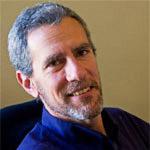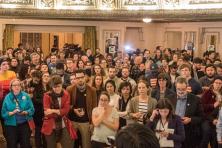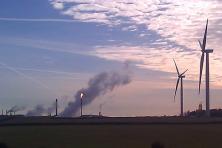This week in Anchorage, President Obama offered a beautiful, strong speech about the need for an epic response to climate change. But across the Northwest, our region still burns; and the President is permitting Shell to fan the flames with Arctic drilling.
It’s not that the President doesn’t mean the words he spoke. It’s that he, like all of us, is struggling to escape the dissonance and hypocrisy of a system in which we feed the beast even as we fight it. Yet he, as much as any human, can change that system. He could ring a loud clear bell right now that would call us to solutions much more clearly and irresistibly than this speech alone.
Here’s the conspicuous missing piece, the elephant in the room: It’s not just that we are “not moving fast enough” in the right direction. It’s that we are continuing to move in the wrong direction. Even as we accelerate solutions, we are continuing to approve massive, new, irreversible economic commitments – like Arctic drilling – that make the problem not just worse, but intractable. Yes, we need to move faster on solutions. But above all, right now, before it’s too late, we need to stop aggravating the problem, or no acceleration of solutions will ever be enough. From here we must go forward, only forward.
As true and welcome as the President’s words are, they are hollow until he stands up to the fossil fuel industry… until he applies the decision rule he said he would use for Keystone XL – he will reject the pipeline if it “significantly exacerbates the problem of carbon pollution” – as a clear and consistent policy. That simple, firm “No” is the key that can unlock the big “Yes”: the clean energy revolution.
The President’s speech:
REMARKS BY THE PRESIDENT AT GLACIER CONFERENCE
Dena’ina Civic and Convention Center, Anchorage, Alaska
THE PRESIDENT: Thank you so much. Thank you. It is wonderful to be here in the great state of Alaska.
I want to thank Secretary Kerry and members of my administration for your work here today. Thank you to the many Alaskans, Alaska Natives and other indigenous peoples of the Arctic who’ve traveled a long way, in many cases, to share your insights and your experiences. And to all the foreign ministers and delegations who’ve come here from around the world -- welcome to the United States, and thank you all for attending this GLACIER Conference.
The actual name of the conference is much longer. It’s a mouthful, but the acronym works because it underscores the incredible changes that are taking place here in the Arctic that impact not just the nations that surround the Arctic, but have an impact for the entire world, as well.
I want to thank the people of Alaska for hosting this conference. I look forward to visiting more of Alaska over the next couple of days. The United States is, of course, an Arctic nation. And even if this isn’t an official gathering of the Arctic Council, the United States is proud to chair the Arctic Council for the next two years. And to all the foreign dignitaries who are here, I want to be very clear -- we are eager to work with your nations on the unique opportunities that the Arctic presents and the unique challenges that it faces. We are not going to -- any of us -- be able to solve these challenges by ourselves. We can only solve them together.
Of course, we’re here today to discuss a challenge that will define the contours of this century more dramatically than any other -- and that’s the urgent and growing threat of a changing climate.
Our understanding of climate change advances each day. Human activity is disrupting the climate, in many ways faster than we previously thought. The science is stark. It is sharpening. It proves that this once-distant threat is now very much in the present.
In fact, the Arctic is the leading edge of climate change -- our leading indicator of what the entire planet faces. Arctic temperatures are rising about twice as fast as the global average. Over the past 60 years, Alaska has warmed about twice as fast as the rest of the United States. Last year was Alaska’s warmest year on record -- just as it was for the rest of the world. And the impacts here are very real.
Thawing permafrost destabilizes the earth on which 100,000 Alaskans live, threatening homes, damaging transportation and energy infrastructure, which could cost billions of dollars to fix.
Warmer, more acidic oceans and rivers, and the migration of entire species, threatens the livelihoods of indigenous peoples, and local economies dependent on fishing and tourism. Reduced sea levels leaves villages unprotected from floods and storm surges. Some are in imminent danger; some will have to relocate entirely. In fact, Alaska has some of the swiftest shoreline erosion rates in the world.
I recall what one Alaska Native told me at the White House a few years ago. He said, “Many of our villages are ready to slide off into the waters of Alaska, and in some cases, there will be absolutely no hope -– we will need to move many villages.”
Alaska’s fire season is now more than a month longer than it was in 1950. At one point this summer, more than 300 wildfires were burning at once. Southeast of here, in our Pacific Northwest, even the rainforest is on fire. More than 5 million acres in Alaska have already been scorched by fire this year -- that's an area about the size of Massachusetts. If you add the fires across Canada and Siberia, we’re talking 300 [30] million acres -– an area about the size of New York.
This is a threat to many communities -- but it’s also an immediate and ongoing threat to the men and women who put their lives on the line to protect ours. Less than two weeks ago, three highly trained firefighters lost their lives fighting a fire in Washington State. Another has been in critical condition. We are thankful to each and every firefighter for their heroism -- including the Canadian firefighters who’ve helped fight the fires in this state.
But the point is that climate change is no longer some far-off problem. It is happening here. It is happening now. Climate change is already disrupting our agriculture and ecosystems, our water and food supplies, our energy, our infrastructure, human health, human safety -- now. Today. And climate change is a trend that affects all trends -- economic trends, security trends. Everything will be impacted. And it becomes more dramatic with each passing year.
Already it’s changing the way Alaskans live. And considering the Arctic’s unique role in influencing the global climate, it will accelerate changes to the way that we all live.
Since 1979, the summer sea ice in the Arctic has decreased by more than 40 percent -- a decrease that has dramatically accelerated over the past two decades. One new study estimates that Alaska’s glaciers alone lose about 75 gigatons -- that’s 75 billion tons -- of ice each year.
To put that in perspective, one scientist described a gigaton of ice as a block the size of the National Mall in Washington -- from Congress all the way to the Lincoln Memorial, four times as tall as the Washington Monument. Now imagine 75 of those ice blocks. That’s what Alaska’s glaciers alone lose each year. The pace of melting is only getting faster. It’s now twice what it was between 1950 and 2000 -- twice as fast as it was just a little over a decade ago. And it’s one of the reasons why sea levels rose by about eight inches over the last century, and why they’re projected to rise another one to four feet this century.
Consider, as well, that many of the fires burning today are actually burning through the permafrost in the Arctic. So this permafrost stores massive amounts of carbon. When the permafrost is no longer permanent, when it thaws or burns, these gases are released into our atmosphere over time, and that could mean that the Arctic may become a new source of emissions that further accelerates global warming.
So if we do nothing, temperatures in Alaska are projected to rise between six and 12 degrees by the end of the century, triggering more melting, more fires, more thawing of the permafrost, a negative feedback loop, a cycle -- warming leading to more warming -- that we do not want to be a part of.
And the fact is that climate is changing faster than our efforts to address it. That, ladies and gentlemen, must change. We’re not acting fast enough.
I’ve come here today, as the leader of the world’s largest economy and its second largest emitter, to say that the United States recognizes our role in creating this problem, and we embrace our responsibility to help solve it. And I believe we can solve it. That’s the good news. Even if we cannot reverse the damage that we’ve already caused, we have the means -- the scientific imagination and technological innovation -- to avoid irreparable harm.
We know this because last year, for the first time in our history, the global economy grew and global carbon emissions stayed flat. So we’re making progress; we’re just not making it fast enough.
Here in the United States, we’re trying to do our part. Since I took office six and a half years ago, the United States has made ambitious investments in clean energy, and ambitious reductions in our carbon emissions. We now harness three times as much electricity from wind and 20 times as much from the sun. Alaskans now lead the world in the development of hybrid wind energy systems from remote grids, and it’s expanding its solar and biomass resources.
We’ve invested in energy efficiency in every imaginable way -- in our buildings, our cars, our trucks, our homes, even the appliances inside them. We’re saving consumers billions of dollars along the way. Here in Alaska, more than 15,000 homeowners have cut their energy bills by 30 percent on average. That collectively saves Alaskans more than $50 million each year. We’ve helped communities build climate-resilient infrastructure to prepare for the impacts of climate change that we can no longer prevent.
Earlier this month, I announced the first set of nationwide standards to end the limitless dumping of carbon pollution from our power plants. It’s the single most important step America has ever taken on climate change. And over the course of the coming days, I intend to speak more about the particular challenges facing Alaska and the United States as an Arctic power, and I intend to announce new measures to address them.
So we are working hard to do our part to meet this challenge. And in doing so, we’re proving that there doesn’t have to be a conflict between a sound environment and strong economic growth. But we’re not moving fast enough. None of the nations represented here are moving fast enough.
And let’s be honest -- there’s always been an argument against taking action. The notion is somehow this will curb our economic growth. And at a time when people are anxious about the economy, that’s an argument oftentimes for inaction. We don’t want our lifestyles disrupted. In countries where there remains significant poverty, including here in the United States, the notion is, can we really afford to prioritize this issue. The irony, of course, is, is that few things will disrupt our lives as profoundly as climate change. Few things can have as negative an impact on our economy as climate change.
On the other hand, technology has now advanced to the point where any economic disruption from transitioning to a cleaner, more efficient economy is shrinking by the day. Clean energy and energy efficiency aren’t just proving cost-effective, but also cost-saving. The unit costs of things like solar are coming down rapidly. But we’re still underinvesting in it.
Many of America’s biggest businesses recognize the opportunities and are seizing them. They’re choosing a new route. And a growing number of American homeowners are choosing to go solar every day. It works. All told, America’s economy has grown more than 60 percent over the last 20 years, but our carbon emissions are roughly back to where they were 20 years ago. So we know how to use less dirty fuel and grow our economy at the same time. But we’re not moving fast enough.
More Americans every day are doing their part, though. Thanks to their efforts, America will reach the emission target that I set six years ago. We're going to reduce our carbon emissions in the range of 17 percent below 2005 levels by 2020. And that’s why, last year, I set a new target: America is going to reduce our emissions 26 to 28 percent below 2005 levels by 10 years from now.
And that was part of a historic joint announcement we made last year in Beijing. The United States will double the pace at which we cut our emissions, and China committed, for the first time, to limiting its emissions. Because the world’s two largest economies and two largest emitters came together, we’re now seeing other nations stepping up aggressively as well. And I’m determined to make sure American leadership continues to drive international action -- because we can’t do this alone. Even America and China together cannot do this alone. Even all the countries represented around here cannot do this alone. We have to do it together.
This year, in Paris, has to be the year that the world finally reaches an agreement to protect the one planet that we’ve got while we still can.
So let me sum up. We know that human activity is changing the climate. That is beyond dispute. Everything else is politics if people are denying the facts of climate change. We can have a legitimate debate about how we are going to address this problem; we cannot deny the science. We also know the devastating consequences if the current trend lines continue. That is not deniable. And we are going to have to do some adaptation, and we are going to have to help communities be resilient, because of these trend lines we are not going to be able to stop on a dime. We’re not going to be able to stop tomorrow.
But if those trend lines continue the way they are, there’s not going to be a nation on this Earth that’s not impacted negatively. People will suffer. Economies will suffer. Entire nations will find themselves under severe, severe problems. More drought; more floods; rising sea levels; greater migration; more refugees; more scarcity; more conflict.
That’s one path we can take. The other path is to embrace the human ingenuity that can do something about it. This is within our power. This is a solvable problem if we start now.
And we’re starting to see that enough consensus is being built internationally and within each of our own body politics that we may have the political will -- finally -- to get moving.
So the time to heed the critics and the cynics and the deniers is past. The time to plead ignorance is surely past. Those who want to ignore the science, they are increasingly alone. They’re on their own shrinking island. (Applause.)
And let’s remember, even beyond the climate benefits of pursuing cleaner energy sources and more resilient, energy-efficient ways of living, the byproduct of it is, is that we also make our air cleaner and safer for our children to breathe. We’re also making our economies more resilient to energy shocks on global markets. We’re also making our countries less reliant on unstable parts of the world. We are gradually powering a planet on its way to 9 billion humans in a more sustainable way.
These are good things. This is not simply a danger to be avoided; this is an opportunity to be seized. But we have to keep going. We’re making a difference, but we have to keep going. We are not moving fast enough.
If we were to abandon our course of action, if we stop trying to build a clean-energy economy and reduce carbon pollution, if we do nothing to keep the glaciers from melting faster, and oceans from rising faster, and forests from burning faster, and storms from growing stronger, we will condemn our children to a planet beyond their capacity to repair: Submerged countries. Abandoned cities. Fields no longer growing. Indigenous peoples who can’t carry out traditions that stretch back millennia. Entire industries of people who can’t practice their livelihoods. Desperate refugees seeking the sanctuary of nations not their own. Political disruptions that could trigger multiple conflicts around the globe.
That’s not a future of strong economic growth. That is not a future where freedom and human rights are on the move. Any leader willing to take a gamble on a future like that -- any so-called leader who does not take this issue seriously or treats it like a joke -- is not fit to lead.
On this issue, of all issues, there is such a thing as being too late. That moment is almost upon us. That’s why we’re here today. That’s what we have to convey to our people -- tomorrow, and the next day, and the day after that. And that’s what we have to do when we meet in Paris later this year. It will not be easy. There are hard questions to answer. I am not trying to suggest that there are not going to be difficult transitions that we all have to make. But if we unite our highest aspirations, if we make our best efforts to protect this planet for future generations, we can solve this problem.
And when you leave this conference center, I hope you look around. I hope you have the chance to visit a glacier. Or just look out your airplane window as you depart, and take in the God-given majesty of this place. For those of you flying to other parts of the world, do it again when you’re flying over your home countries. Remind yourself that there will come a time when your grandkids -- and mine, if I’m lucky enough to have some -- they’ll want to see this. They’ll want to experience it, just as we’ve gotten to do in our own lives. They deserve to live lives free from fear, and want, and peril. And ask yourself, are you doing everything you can to protect it. Are we doing everything we can to make their lives safer, and more secure, and more prosperous?
Let’s prove that we care about them and their long-term futures, not just short-term political expediency.
I had a chance to meet with some Native peoples before I came in here, and they described for me villages that are slipping into the sea, and the changes that are taking place -- changing migratory patterns; the changing fauna so that what used to feed the animals that they, in turn, would hunt or fish beginning to vanish. It’s urgent for them today. But that is the future for all of us if we don’t take care.
Your presence here today indicates your recognition of that. But it’s not enough just to have conferences. It’s not enough just to talk the talk. We’ve got to walk the walk. We’ve got work to do, and we’ve got to do it together.
So, thank you. And may God bless all of you, and your countries. And thank you, Alaska, for your wonderful hospitality. Thank you.





